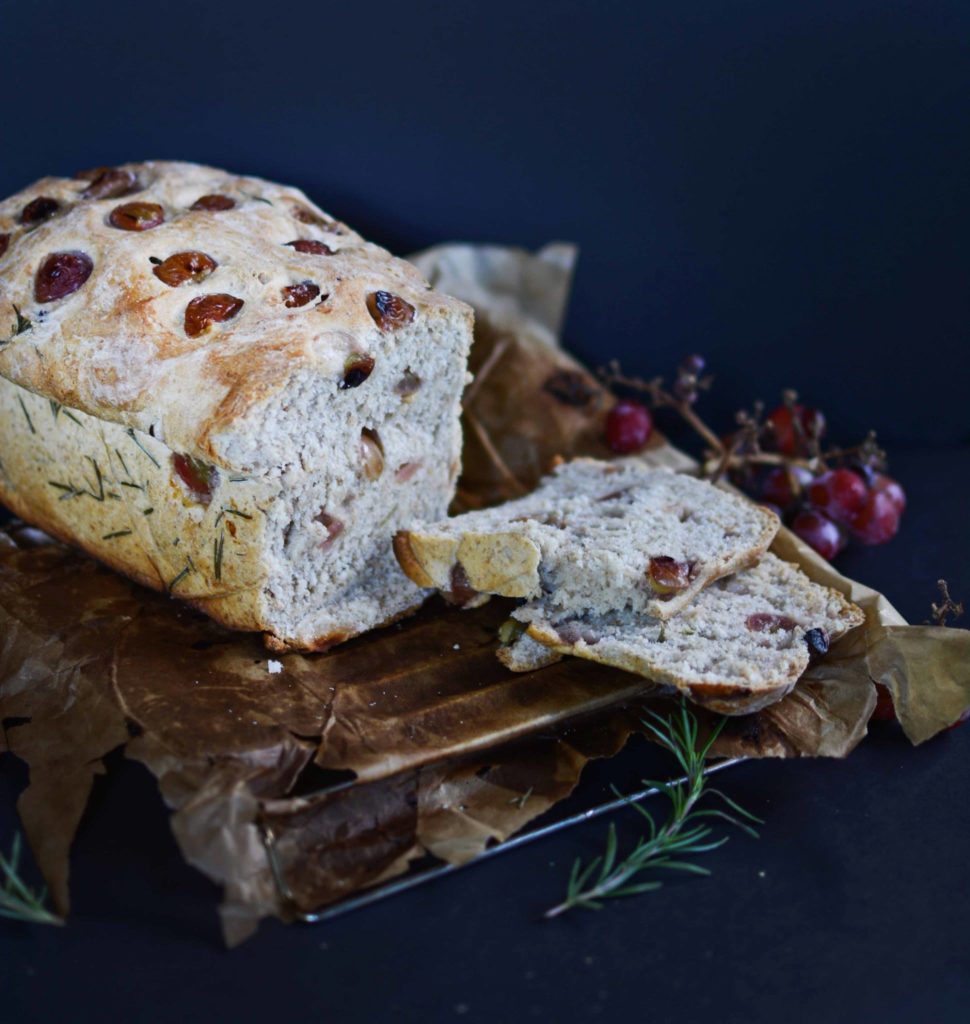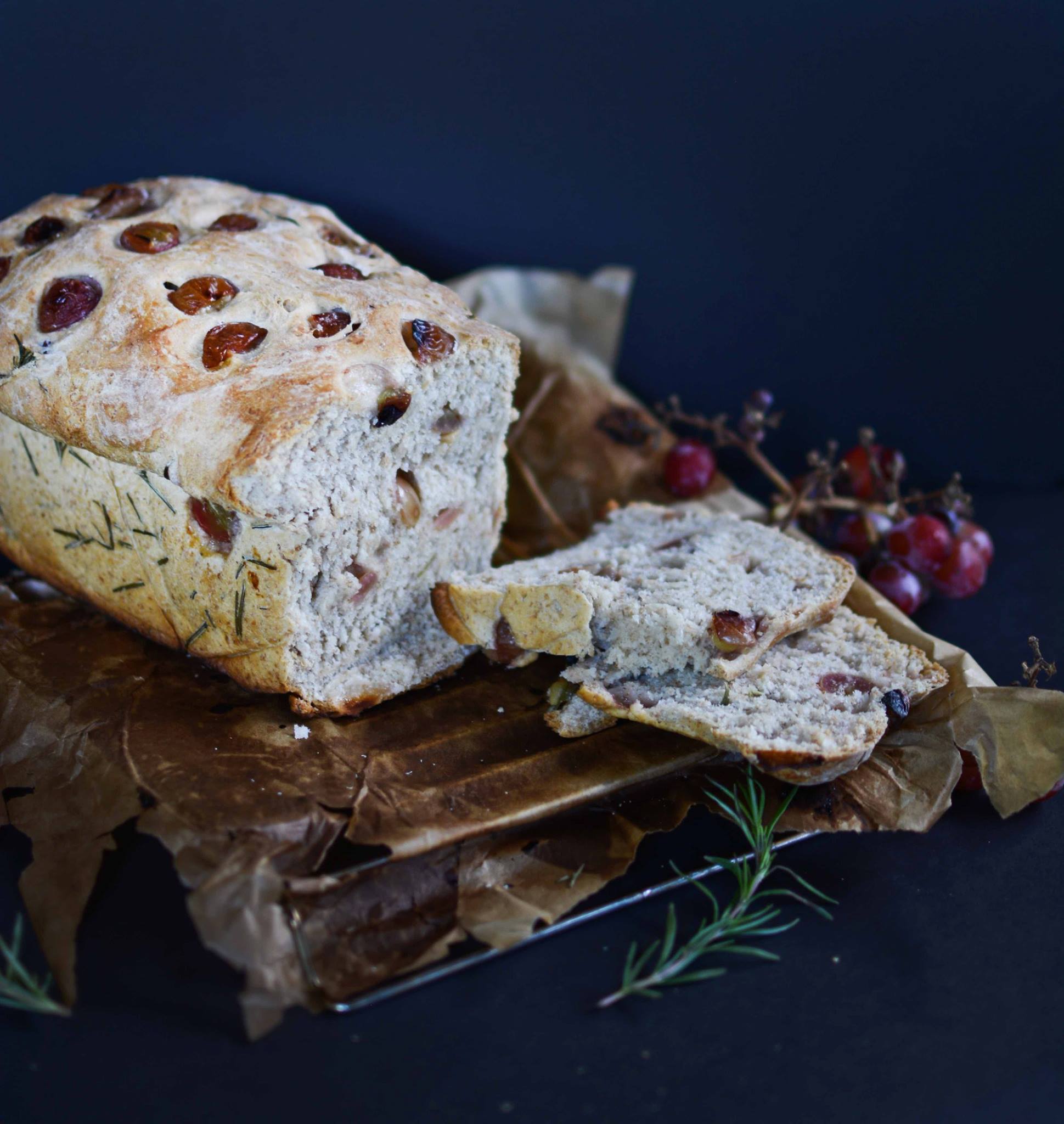Pan de uvas y romero | Grape Rosemary Bread

Hacer pan puede ser complicado, pero una vez que entiendas cómo funciona la levadura y como manipularla, hacer pan es pan comido. Mi Nonna (abuela) hacía pan todo el día, todos los días, y de todo tipo. De manteca, brioche, integral, blanco, de centeno… el mejor pan del mundo! Mis primos y mis hermanos lo amabamos tanto que mi abuela lo tenía que esconder para que no nos de dolor de panza! Pienso en ella cada vez que hago pan, y creo que hace que mi pan sea mas rico y crezca más!
Ahora sí, a lo práctico… unos tips para hacer pan:
1. Hacer una esponja: ¿qué es esto? … una esponja es 1 1/2 cucharadita de levadura seca en 1 taza de agua tibia (no caliente, no fría, esto es muy importante!) con 1 cucharadita de azúcar o miel (esto despierta la levadura!) y unas cucharadas de harina. Primero calentar el agua y añadir el azúcar. A continuación, añadir la levadura y revolver hasta que aparezcan burbujas en la superficie. Una vez pase esto, añadir la harina y revolver. Cubrir durante 15 minutos en un lugar calentito. Este proceso hace que obtengas una miga rica y con aire!
2. Hacer un volcán: este consejo es mi abuela. Ella agarraba un bowl grande, ponía una gran parte de la harina que iba a utilizar y le hacía un agujero en el medio. Luego colocaba la esponja adentro e integraba la harina y la esponja lentamente con la ayuda de las manos. Esto hace que no tengas grumos, y que la masa sea linda y suavecita.
3. Use agua tibia: no agregues agua fría o agua caliente a la mezcla de pan, mata la levadura y el pan no crece bien.
4. Usa tus manos: las manos son cálidas, y hace que la masa se sienta mas tranquila para crecer. Te puede sonar raro, pero no es lo mismo hacer pan con una maquina que hacer pan con las manos…
5. Paciencia: Hacer pan es un proceso de 3 horas, por lo menos. No lo hagas apurado, porque el pan te va a odiar, y vos vas a odiar el pan.
Esta receta lleva uvas y romero, pero con la misma receta, sin estos ingredientes, sale un pan integral muy rico! Una vez que domines los pasos básicos, podes hacer el pan que quieras!
–
Making bread can be tricky, but once you understand how yeast works and how to manipulate it, making bread is really easy. My grandmother taught me this. She was Italian, and made every kind of delicious breads: butter, brioche, whole-wheat, white, mixed… and my cousins, siblings and me loves them all! I remember her every time I make bread and love the feeling of it.
Here are a few tips:
1. Make a sponge: what is this, you may wonder… a sponge is 1 1/2 tsp of dry yeast in 1 cup of lukewarm water (not hot, not cold, this is very important!) with 1 tsp of sugar or honey (this awakens the yeast!) and a few tablespoons of flour. First warm the water and add the sugar. Then add the yeast and stir until bubbles appear in the surface. Once this happens, add the flour and stir. Cover for 15 minutes and store in a warm place. This process will make your bread super fluffy!
2. Make a volcano: this tip is my grandmothers, she used to make a volcano with the flour. Place it in a large bowl, make a hole in the middle. Add the sponge inside and slowly integrate the flour to the sponge.
3. Use warm water: don’t add cold water or hot water to the bread mix, it will kill the yeast, and your bread won’t grow.
4. Use your hands: your hands are warm, and make the best nest for yeast. It may sound weird but, using your hands really does make a difference when you make bread.
5. Be patient: making bread is a 3 hour process. Don’t make it in a rush, because they bread will hate it, and you will hate the bread.
This recipe involves grapes and rosemary, but you can make plain bread with the same recipe, or add any combination you like! Once you master the basic steps, you can become a master baker!
PAN DE UVAS Y ROMERO
INGREDIENTES
ESPONJA
- 1 1/2 cucharaditas de levadura seca
- 1 taza de agua tibia
- 1 cucharadita de azúcar crudo o mascabo
- 1/4 taza de harina integral
MASA
- 2 tazas de harina integral
- 2 tazas de harina blanca (tener un poco más, en caso de ser necesario)
- 2+ tazas agua tibia (depende mucho del clima, si hay clima seco, necesitarás más agua, y si hay mucha húmedad, menos, lo podes medir a medida que la agregas, ya que hay que agregarla de a poco)
- 1/4 taza de aceite de oliva
- 2 cucharadas de sal marina
AGREGADOS
- 1 1/2 tazas de uvas
- 1 manojo de romero fresco
PREPARACIÓN
ESPONJA
- En un bol chico, mezclar agua tibia con azúcar y revolver bien.
- Agregar la levadura y mezclar, hasta que aparezcan burbujas.
- Agregar harina y mezclar hasta lograr una masa muy húmeda.
- Tapar y dejar crecer por 15 minutos en un lugar sin corrientes de aire y calentito.
MASA
- En un bol grande, mezclar la harina integral con la blanca y hacer un hueco en el medio.
- Agregar la esponja dentro, y ir integrando de a poco la harina con la esponja.
- Agregar agua tibia, de a poco, e integrando simultaneamente. La idea es agregar agua hasta que la masa quede blanda, pero no pegajosa. (TIP: Podes ir agregando harina a tus manos y frotarlas para limpiarlas)
- Agregar aceite de oliva y sal marina.
- Tapar con un repasador y servilleta grande y guardar en un lugar sin corrientes de aire y calentito por 30 minutos.
- Cuando pasen los 30 minutos, la masa debería haber duplicado su tamaño.
- Sacarla del bol, y golpearla para sacarle el aire. Amasar con harina sobre la mesada por 5 minutos, golpeandola para abajo y empujandola para atrás. Agregar harina si es necesario.
AGREGADOS
- Luego de la primer crecimiento de masa, cortar las uvas y picar el romero.
- Agregarlo a la masa, amasandolo dentro de ella.
- Poner en un bol, tapar con un repasador y servilleta grande y guardar en un lugar sin corrientes de aire y calentito por 30 minutos más.
- Pre-calentar el horno a 180C/350F.
- Sacar la masa del bol, y golpearla para sacarle el aire. Amasar con harina sobre la mesada por 5 minutos, golpeandola para abajo y empujandola para atrás. Agregar harina si es necesario.
- Tomar el molde de pan, y ponerle aceite de oliva.
- Poner la masa en el molde de pan y dejar levar por 15 minutos más.
- Introducir al horno y hornear por 30-40 minutos.
- Una vez listo, sacar del horno, remover del molde y dejar enfriar por 15 minutos antes de cortarlo.
–
GRAPE AND ROSEMARY BREAD
INGREDIENTS
SPONGE
- 1 1/2 teaspoons dry yeast
- 1 cup lukewarm water
- 1 teaspoon raw sugar
- 1/4 cup whole wheat flour
DOUGH
- 2 cups whole wheat flour
- 2 cups white flour (have a bit more at hand)
- 2+ cups warm water
- 1/4 cup olive oil
- 2 tablespoons sea salt
TOPPINGS
- 1 1/2 cups grapes
- 1 bunch of fresh rosemary
METHOD
SPONGE
- In a small bowl, mix lukewarm water with sugar.
- Add the yeast and stir until bubbles appear on surface.
- Add flour and mix. You will get a very moist dough, this is how it’s supposed to be.
- Cover and let the sponge rise for 15 minutes in a free drafts and warm area.
DOUGH
- In a large bowl, mix the wheat with white flour and make a hole in the middle.
- Add the sponge in the hole, and slowly incorporate the flour with the sponge.
- Add warm water, slowly, and integrating simultaneously. The idea is to add water until the dough is soft but not sticky. (TIP: You can clean your hands by rubbing your hands with flour)
- Add olive oil and sea salt.
- Cover with a towel and store in a free drafts and warm area for 30 minutes.
- After 30 minutes, the dough should have doubled in size.
- Get the dough out of the bowl and get the air out of it by kneading it. Knead out the air by knocking down and pushing back the dough. Add flour if necessary.
TOPPINGS
- After the dough’s first growth, slice the grapes and chop the rosemary.
- Add it to the dough by kneading them in.
- Put in a bowl, cover with a towel and store in a draft free and warm area for another 30 minutes.
- Pre-heat the oven to 180C / 350F.
- Remove dough from bowl and get the air out of it. Knead out the air by knocking down and pushing back the dough. Add flour if necessary.
- Take the bread pan, and cover it with olive oil to prevent sticking.
- Put the dough into the loaf pan and let rise for another 15 minutes.
- Bake for 30-40 minutes.
- Once ready, remove from oven, remove from loaf pan and let cool for 15 minutes before slicing.
